While they each have different strengths and weaknesses, .308 and .270 Winchester cartridges are both proven performers. So, the question central to the 270 vs 308 debate remains: which one should you be hunting with?
Why the heck would anybody want to compare the 270 vs 308 cartridges? After all, these two rounds not only use different caliber bullets, but one is a short action cartridge and the other is a bigger long action cartridge.
Even so, and despite their big physical difference, the 308 and 270 are both extremely popular hunting round all over the world. There’s also a surprising amount of overlap in their performance and ideal use cases too.
To be perfectly candid with you, it’s impossible to pick a true across the board “winner” of the .270 Winchester vs .308 Winchester debate. However, each cartridge has different strengths and weaknesses and, despite the overlap in their capabilities, each one is ideally suited for different hunting tasks.
In this article, I discuss the pros and cons of the 270 vs 308 so you can make an informed decision on which one is best for you.
Table of Contents
Before we get started, I have a couple of administrative notes:
Some of the links below are affiliate links. This means I will earn a small commission (at no extra cost to you) if you make a purchase. This helps support the blog and allows me to continue to create free content that’s useful to hunters like yourself. Thanks for your support.
History Of The 270 Winchester & 308 Winchester
First, I recorded an entire video episode on this exact subject. If you’d rather listen or watch than read, watch the YouTube video below.
Like many other cartridges developed in the United States, the story of the .270 and .308 Winchester begins with the .30-06 Springfield.
The US Army began the search for a new rifle and cartridge after receiving a deadly demonstration of the capabilities of the revolutionary new Mauser rifle and 7mm Mauser cartridge in the hands of Spanish troops in Cuba during 1898. Those efforts bore fruit a few years later with the bolt action 1903 Springfield rifle chambered in the new .30-06 Springfield cartridge.
Using smokeless powder and a 150gr pointed bullet fired at 2,700fps, the .30-06 Springfield was a gigantic improvement over other popular American cartridges used during that era like the .30-30 Winchester, 30-40 Krag, and the .45-70 Government.
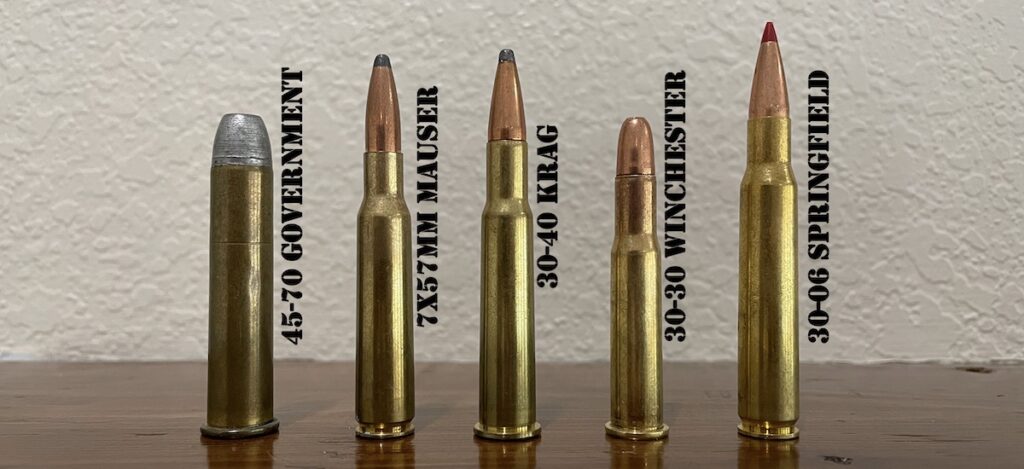
Not surprisingly, the ultra-modern .30-06 Springfield was an almost instant success in the civilian market.
While many were satisfied with the .30-06 from the start, wildcatters also quickly started modifying the cartridge for more specialized tasks. Some gun designers necked up the .30-06 to develop bigger cartridges like the .35 Whelen and .400 Whelen.
However, the folks at Winchester went the opposite route and necked down the .30-06 to use .277″ instead of .308″ bullets. They formally released the resulting .270 Winchester cartridge in 1925 with the Winchester Model 54 rifle.
The original .270 Winchester ammunition fired a 130 grain bullet at a velocity of 3,140 feet per second (2,846 ft-lbs of energy). This was a screaming fast high velocity for the 1920s and the cartridge delivered a gigantic speed improvement over the .30-06 Springfield, which was itself a high velocity cartridge at the time.
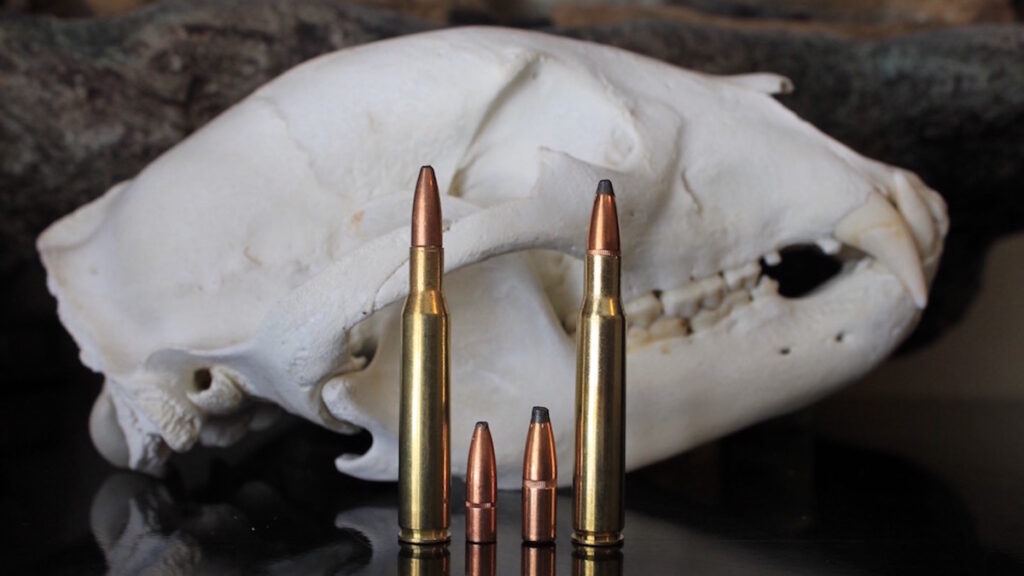
If you’d like to see how the .270 Winchester compares to its parent case in the .30-06, read the article below:
270 vs 30-06 Debate Settled Once And For All
While the .270 had a very high muzzle velocity compared to other popular cartridges of the day, it was not an instant commercial success. This was due to a number of reasons, one of which was the fact that the .270 Winchester fired unusual size bullets.
Instead of .284″ bullets like the 7mm Mauser (and more recently developed cartridges like the 7mm-08, .280 Remington, .280 Ackley Improved, and 7mm Remington Magnum), the .270 Winchester used .277″ bullets. This undoubtedly hampered adoption of the cartridge to a certain degree.
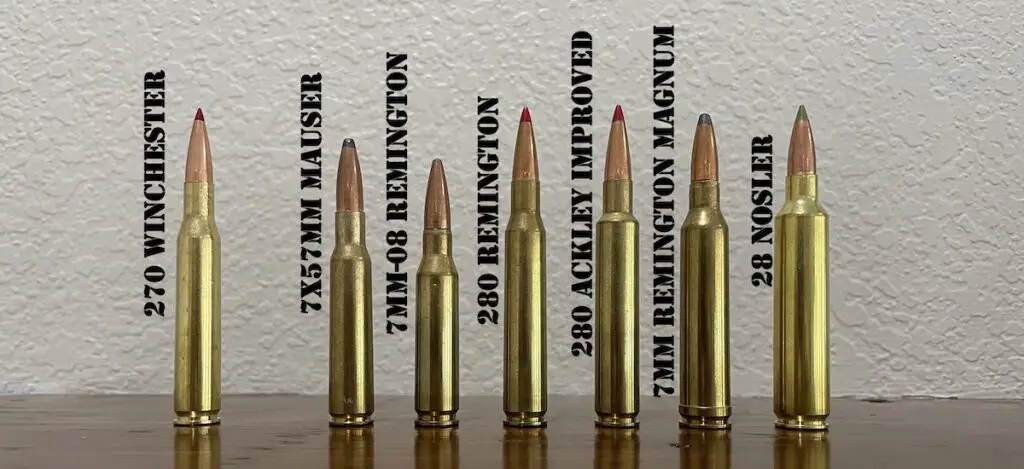
It’s unclear exactly why Winchester opted for .277″ instead of the much more popular .284″ bullets. Regardless of their reasons though, the design team at Winchester went with that bullet diameter and the rest is history.
While the .270 Winchester eventually became a gigantic commercial success for the company, only six other cartridges have used that bore diameter over the course of the next century: the .270 Winchester Short Magnum (270 WSM), the .270 Weatherby Magnum, the 6.8 Remington SPC, the 277 Sig Fury, the 27 Nosler, and the 6.8 Western.
Aside from them, no other mass produced cartridges use .277″ bullets.
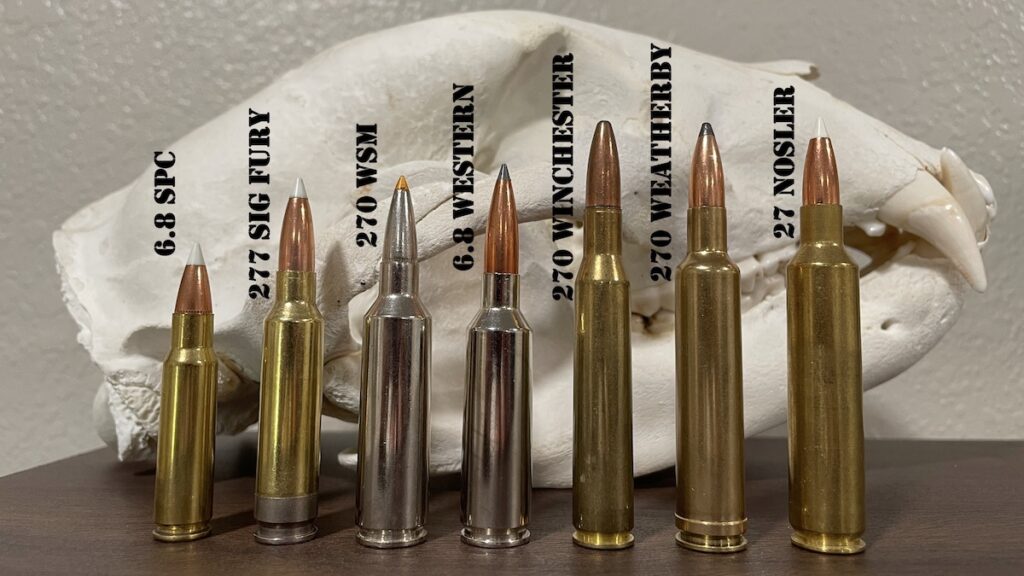
As crazy as it may sound today, many hunters were initially reluctant to adopt the 270 cartridge. On one hand, some hunters derided the killing abilities of the 270 on bigger game (similar to the case with the 6.5 Creedmoor today). At the same time. other hunters said the high velocity of the 270 ruined too much meat on thin skinned game.
Even so, many American hunters eventually came to appreciate the flat shooting characteristics of the round as well as the fact that it was so effective on thin skinned game.
Jack O’Connor was undoubtedly the most influential advocate of the 270 Winchester and he used the cartridge to take nearly any species of game you could think of over the years (including stuff like moose and brown bear) and then chronicled tales of those hunts in his articles for Outdoor Life.
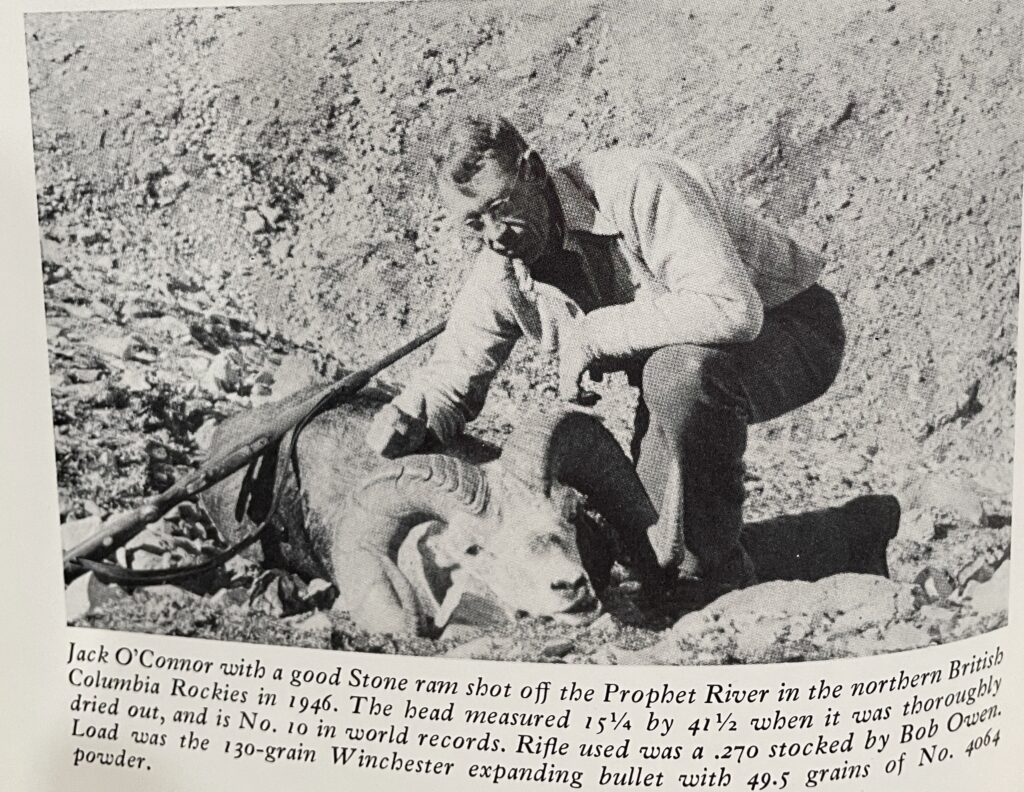
Within a few decades, the .270 Winchester was firmly entrenched as one of the most popular hunting cartridges used in the United States.
Now let’s switch gears and talk about the origins of the 308 Winchester.
While the .30-06 performed very well during both world wars, the US Military again recognized the need for a new rifle and cartridge after World War II. Specifically, the military wanted a new rifle chambered in an intermediate cartridge, capable of automatic fire, and equipped with a detachable magazine like the Soviet AK-47 chambered in the 7.62×39 cartridge.
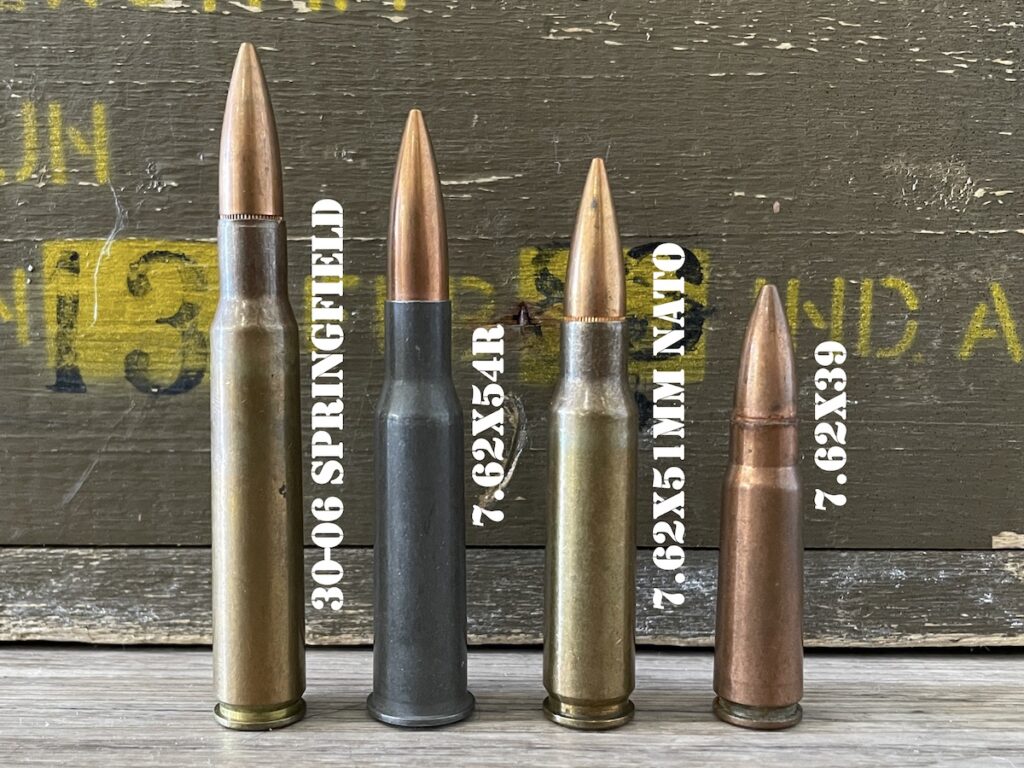
If you’d like to learn more about the evolution of intermediate cartridges, read the article below.
223/5.56 vs 7.62×39: Everything You Need To Know
After a very controversial selection process, the Army eventually settled on the M-14 rifle and the new 7.62x51mm NATO cartridge.
The original 7.62x51mm NATO M80 ball load fired a 146 grain full metal jacket (FMJ) bullet at 2,750 feet per second (2,469 foot pounds of muzzle energy). The 7.62x51mm NATO had virtually the same ballistics as the original .30-06 Springfield load (150 grain bullet at 2,700 feet per second) and also fired a .308″ bullet. However, the 7.62x51mm achieved that performance with a much shorter case (51mm vs 63mm) due to advances in powder technology that occurred after the development of the .30-06.
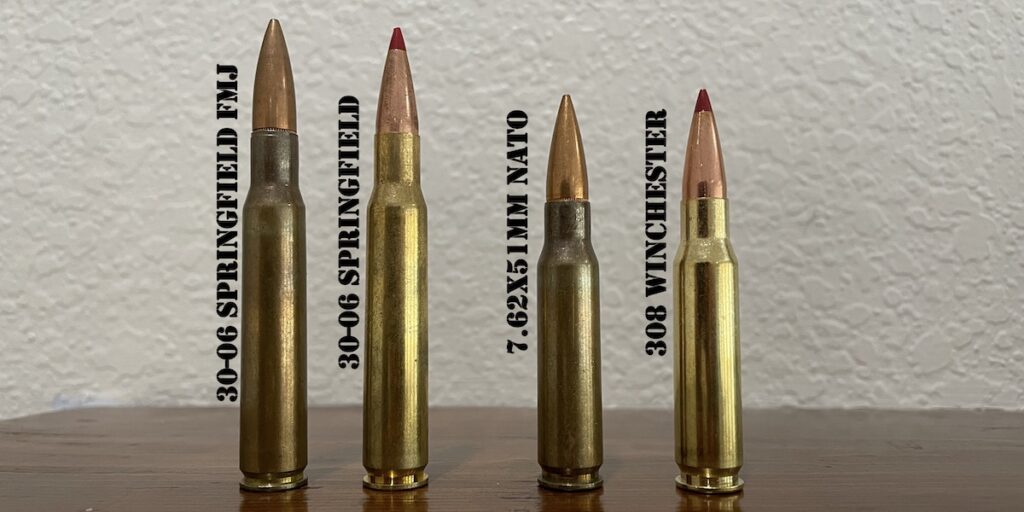
Though the 7.62x51mm NATO had a very short lived career as the primary rifle cartridge for the US military, it’s still widely used by the military in machineguns and sniper/designated marksman rifles. Additionally, Winchester recognized serious commercial potential with the 7.62x51mm cartridge and introduced the extremely similar .308 Winchester cartridge for the civilian hunting and shooting markets in the 1950s.
Providing approximately 90% of the power of the .30-06 in a smaller package, the cartridge also soon became very popular and is now one of the most widely used big game hunting rounds in North America.
If you’d like to learn more about how the .308 Winchester compares to the .30-06 Springfield, read the article below:
308 vs 30-06 vs 300 Win Mag: Which One Should You Be Hunting With?
270 vs 308: Cartridge Sizes
As you can see in the photo below, the .270 Winchester and .308 Winchester cartridges have very different external dimensions.
The .270 Winchester has a significantly longer case length (2.54″ vs 2.015″) as well as overall length (3.34″ vs 2.81″). For this reason, the .270 Winchester is used in standard/long action rifles, while the .308 Winchester is the poster child for short action rifles.
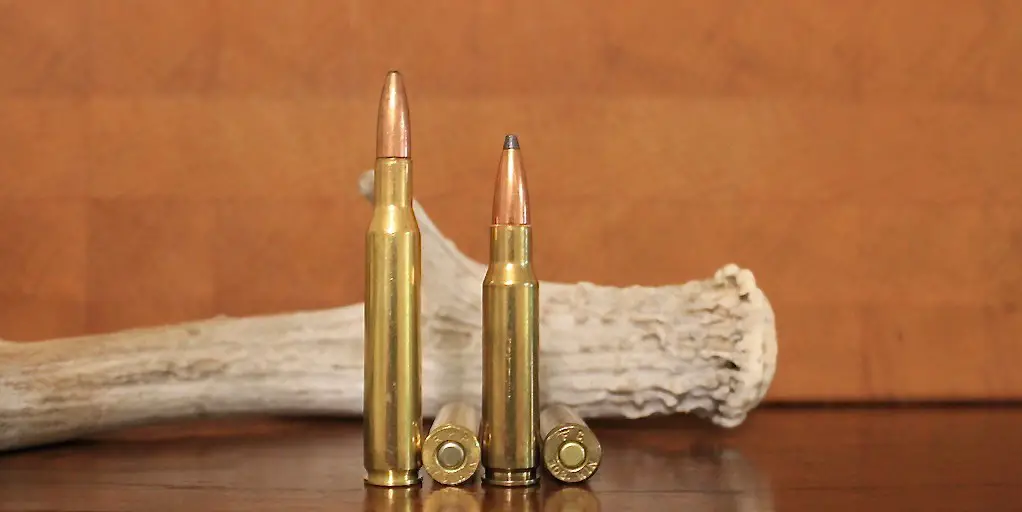
Both cartridges have the same .473″ rim diameter. However, the .308 has a slightly steeper shoulder angle (20 degrees vs 17.5 degrees). Even so, the .270 Winchester has significantly more case capacity due to the much longer case used by the cartridge.
Finally, the .270 Winchester has a slightly higher maximum average pressure authorized by SAAMI (65,000psi vs 62,000psi for the .308 Win).
Note: while the case capacity figures listed below do give a good indication of the differences between the three cartridges, exact case capacities vary slightly according to the brand of brass used.
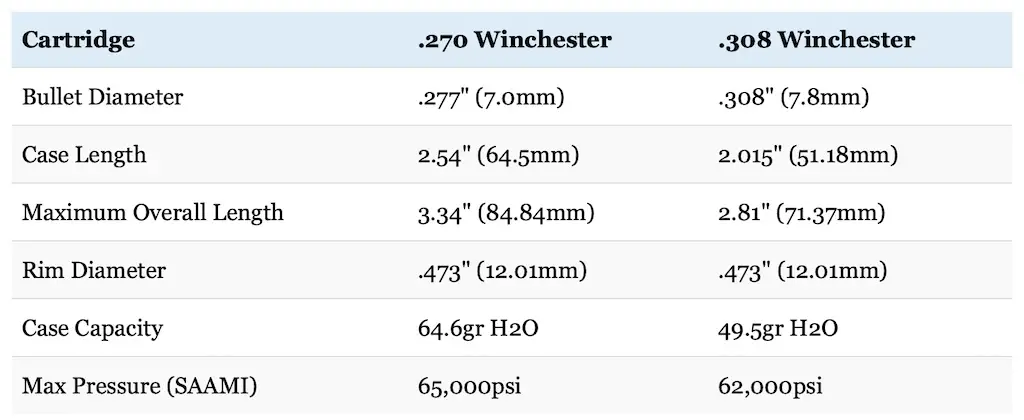
270 vs 308 Ballistics
By necking down the .30-06 case to shoot smaller diameter bullets, the designers of the .270 Winchester built a cartridge with a higher velocity, flatter trajectory, and less recoil than the .30-06 Springfield. Since the .308 Winchester is essentially a scaled down .30-06, with the exception of recoil (which we’ll get to in a minute) the .270 Winchester has the same advantages over the .308 as it does over the .30-06.
However, since most modern .30-06 factory loads have a small edge in velocity (usually around 100-200fps) over .308 factory loads shooting the same weight bullet, the advantage in velocity of the .270 Winchester is even more pronounced when compared to the .308.
This is illustrated below when comparing four different Federal Premium Nosler Partition loads for the two cartridges. Specifically, the table below compares 130gr (.416 BC) and 150gr (.466 BC) loads in .270 Winchester and 150gr (.387 BC) and 180gr (.484 BC) loads in .308 Winchester.
As you can see, the 180gr .308 load uses a slightly more aerodynamic bullet than those used by the .270. However, the 130gr and 150gr Nosler Partition bullets used in this comparison by the .270 are both more aerodynamic than the 150gr .308 bullet.
This data is for Federal factory ammo using a 200 yard zero.
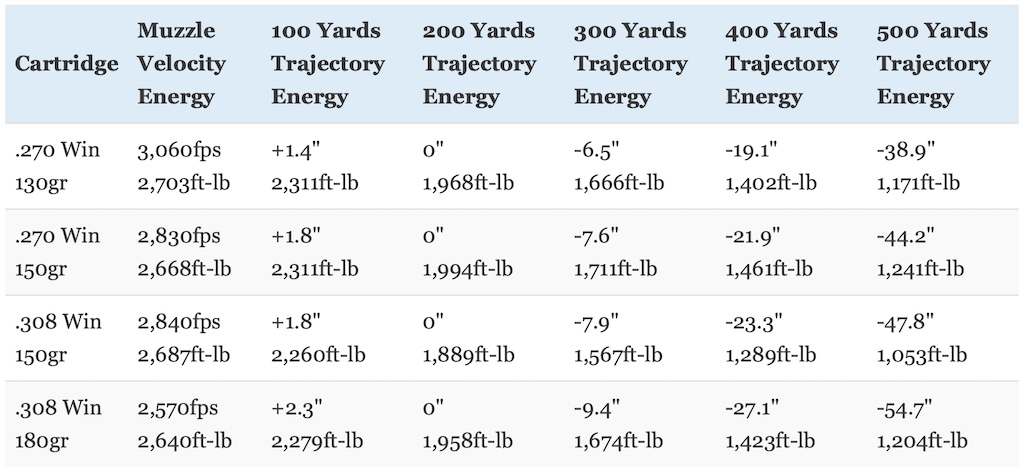
Not surprisingly, there is a significant difference in the bullet trajectories between the two cartridges.
The .270 Winchester has a slight edge over the .308 when both are using 150gr bullets. However, the 130gr .270 load has an even flatter trajectory with 8.9-15.8″ less bullet drop at 500 yards than both .308 Winchester loads.
With regards to energy, the cartridges are fairly evenly matched to start out with. The gap in kinetic energy grows slightly in favor of the .270 when compared to the 150gr .308 Winchester load at all ranges. However, the opposite happens with the more aerodynamic 180gr .308 Winchester load at longer range.
All things considered, the two cartridges are fairly evenly matched in energy, but the 270 Winchester tends to retain more kinetic energy at longer range.
The chart below compares how much a 10 mile per hour crosswind impacts those same four loads out to 500 yards.
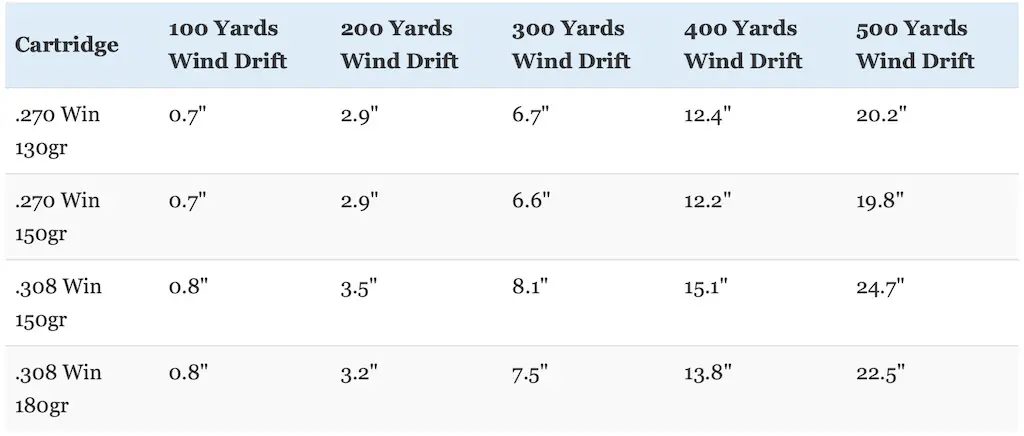
Once again we see that the two cartridges are fairly evenly matched at shorter range, but the .270 has a slight advantage in wind drift that grows as range increases. This is because the .270 Winchester loads shoot more aerodynamic bullets (with the exception of the 180gr .308 load) at a higher velocity.
Now let’s talk about recoil.
The table below compares the recoil produced by 130gr and 150gr .270 loads to 150gr and 180gr .308 loads (all shooting a Nosler Partition bullet) when fired from identical 7 pound rifles.
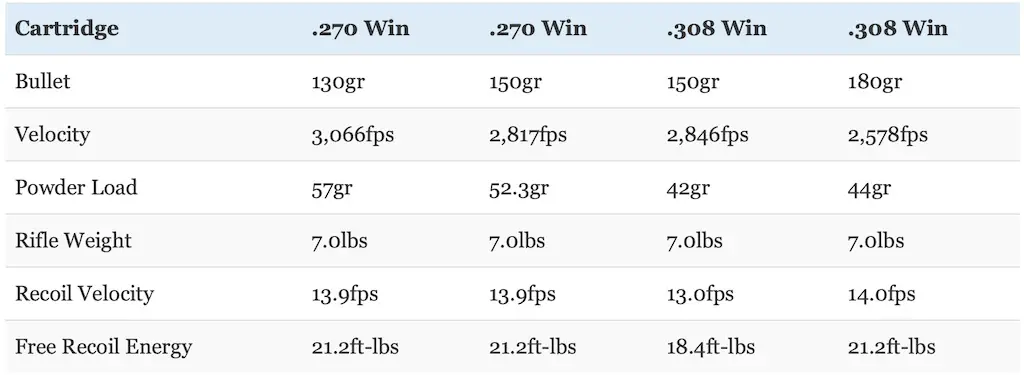
Felt recoil will vary from shooter to shooter and rifle to rifle, but free recoil energy is still a useful way to compare cartridges.
Interestingly, with the exception of the milder recoiling 150gr .308 load, the two cartridges have almost identical recoil.
However, that makes sense when you consider that the .308 and .270 were designed as lower recoiling alternatives to the .30-06. This fits with the original intent of the designers interested in building a mild shooting and easy to handle cartridge that was still powerful enough for hunting medium sized game at short to moderate range.
So where do we stand with each cartridge?
The .270 Winchester is a very flat shooting and moderately powerful cartridge, especially considering that it’s nearly 100 years old. With moderate recoil that’s roughly comparable to the .308 and noticeably lighter than the .30-06 Springfield, most shooters and hunters can handle it without much trouble.
While recoil is more or less comparable between the two cartridges, typical .308 Winchester loads do not have as flat of a trajectory as typical .270 loads.
However, the .308 is available with heavier bullets than the .270 and is available in a wider range of bullet weights and models.
As we’ll discuss in a minute, this is partly due to the widespread use of the .308 Winchester (and other .30 caliber cartridges like the .30-06, .300 Win Mag, .300 Ultra Mag, and 300 PRC) in long distance shooting competitions. These projectiles quite often take advantage of the latest developments in bullet development and offer advantages in precision and ballistic coefficient compared to the bullets used by the .270.
Additionally, there are a couple of other factors that are also worth discussing though.
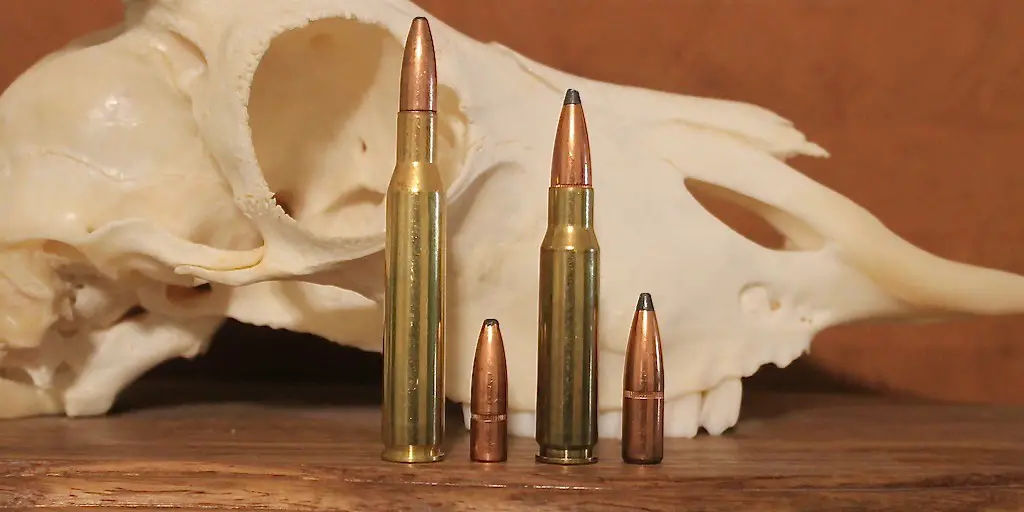
First, the .308 Winchester uses larger diameter bullets than the .270 Winchester.
Specifically, the larger diameter .308″ bullets used by the .308 have about 24% more frontal surface area (also known as cross sectional area) than the .277″ bullets used by the .270 (.0745 vs .0603 square inches). All other things being equal, a bigger bullet will make a bigger hole, cause more tissue damage, and result in more blood loss.
This is a definite, though slight, factor in favor of the .308.
The 308 also has the advantage in the bullet weight department.
For instance, though it’s possible to find .308 ammo shooting bullets weighing as little as 110 grains, most .308 Winchester factory loads designed for big game hunting use heavier weight bullets in the 150 grain to 180 grain range. 150 grain, 165 grain, 168 grain, and 180 grain bullets are most popular for that cartridge.
On the other hand, the majority of .270 Winchester factory loads shoot lighter bullets in the 120-150 grain range. Of these, 130 grain and 150 grain bullets are by far the most common.
Even so, everything else being equal, the smaller diameter bullets used by the .270 Winchester have a higher ballistic coefficient than the larger diameter bullets of the same weight from the .308 Winchester.
However, many of the .277″ bullets have a higher sectional density (SD) than the most common bullets used in the .308 though.
Sectional density (SD) is a measure of the ratio of the diameter of a projectile to its mass. All other things equal, a heavier projectile of a given caliber will be longer and therefore have a higher sectional density and consequently penetrate deeper than projectiles with a lower mass and sectional density.
Everything else being equal, the smaller diameter .277″ bullets have a higher ballistic coefficient and a higher sectional density than the larger diameter bullets of the same weight from the .308.
All that being said, the .270 Winchester still has a slight edge with most bullets in common use, even when compared to heavier .30 caliber bullets.
As an example, 130 grain, 140 grain, and 150 grain .277″ bullets have sectional densities of .242, .261, and .279 respectively. This compares favorably to 150 grain, 168 grain, and 180 grain .308″ bullets which have sectional densities of .226, .253, and .271 respectively.
For the most part, this also applies to ballistic coefficient.
The bullets used in this comparison illustrate those differences well with the .270 Winchester using 130gr (.416 BC) and 150gr (.466 BC) bullets compared to the 150gr (.387 BC) and 180gr (.484 BC) bullets used by the .308.
With the exception of the 180gr .308 bullets, the .270 has the edge across the board with regards to using more aerodynamic bullets in this comparison.
It’s difficult to pick an accuracy winner between the 270 vs 308 though because it’s something of an apples to oranges comparison. Both cartridges are capable of outstanding accuracy, but the .270 Winchester is used almost exclusively as a hunting cartridge. On the other hand, even though the .270 Winchester does shoot flatter in many cases, military and police snipers, hunters, and practical and/or long distance shooting competitors have all used the .308 Winchester extensively over the years.
For that reason, users of the .308 Winchester benefit from the extensive the research and development that has gone into refining .308″ bullets and rifles for long range shooting in the United States over the last century.
All that being said, while the .308 probably has a slight edge here, both cartridges have the potential for excellent accuracy in the right hands.
If you’d like to learn more about the accuracy of the .308 Winchester and how it compares to cartridge purpose built for long range competition shooting, read this article:
6.5 Creedmoor vs 308 Winchester Debate Settled
308 vs 270: Ammunition Selection
The 308 Winchester is one of the most popular centerfire rifle cartridges, both in the United States and the rest of the world. Indeed, only the 223 Remington is more widely used.
However, this does not mean the 270 Winchester is rare. Not at all.
On the contrary, it’s also extremely popular itself and is also likely among the Top 10 most popular centerfire rifle cartridges in the United States.
Even so, the 308 Winchester has a clear advantage over the 270 in factory ammunition availability and selection.
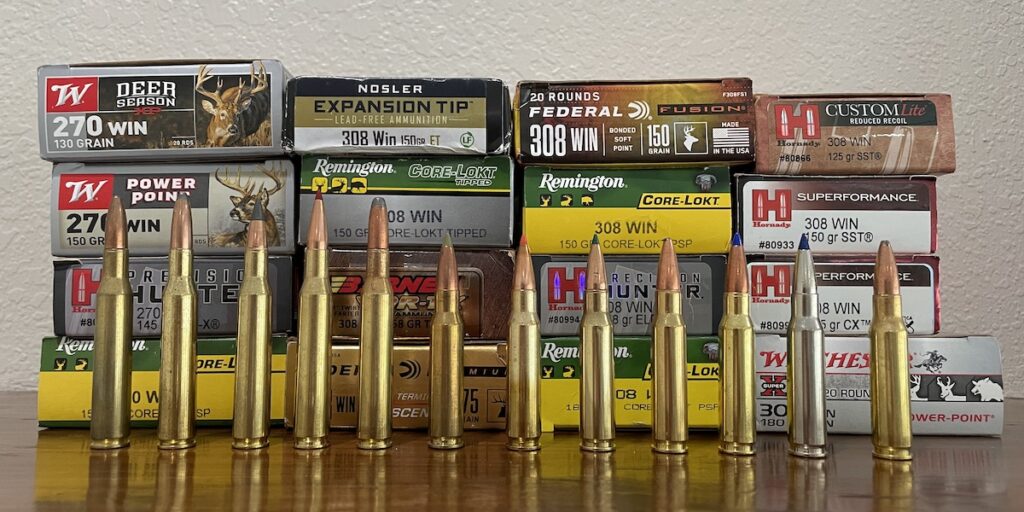
For example, MidwayUSA currently lists 64 270 Winchester loads and 161 308 Winchester loads on their web site as I write this article.
In fact, the 308 Winchester was literally the only high powered centerfire rifle cartridge I never had problems finding hunting ammo for during even the worst points of the 2020-2023 ammo shortage.
Though it was among the first cartridges to come back on shelves (with the 6.5 Creedmoor and 30-06) and availability has continued to improve, it was tough to find 270 Winchester ammo for a few months during the worst of the shortage.
Though there are more 308 ammo options, pretty much every ammunition manufacturer of note like Barnes, Black Hills, Browning, Federal Premium, Fiocchi, Hornady, Magtech, Nosler, PMC, PPU, Remington, Swift, and Winchester (just to name a few) produce a wide variety of ammo for both cartridges.
Prices will vary from region to region and retailer to retailer, but ammunition for both cartridges is often priced at a very similar level. Sometimes prices are identical. Either way, 308 and 270 factory ammo tends to be some of the more affordable hunting ammunition offerings.
For example, MidwayUSA currently sells 270 Winchester ammunition for between $1.10 and $4.00 per round (not including sales tax or shipping).
The same is true for 308 Winchester ammunition.
Basically, there is no shortage of quality .270 Win and .308 Win factory ammunition suitable for hunting.
BUY SOME GREAT 270 HUNTING AMMO HERE
BUY SOME GREAT 308 HUNTING AMMO HERE
If you’d like to learn more about some of the various hunting ammunition choices for the .308 Winchester and .270 Winchester cartridges, read the articles below:
Best 270 Ammo For Hunting Elk, Deer, And Other Big Game
Best 308 Ammo For Hunting Deer, Elk, Hogs, & Other Game
308 vs 270: Rifle Selection
Similar to the abundant ammunition choices available in .308 Winchester and .270 Winchester, there are also plenty of quality rifles manufactured in the two cartridges.
The 270 originally hit the market at the same time as the Winchester Model 54 rifle. The 270 was also one of the original offerings for the Winchester Model 70 rifle when it came on the scene in 1936.
In fact, only the 30-06 was a more popular offering in the Model 70 and fully 20% of all the Model 70s produced before Winchester overhauled the design in 1963 were chambered in 270.
Coming along in 1952, Winchester originally offered the 308 in the Model 70 from the start along with their Lever Action Model 88 and semi-automatic Model 100.
Winchester still offers both cartridges in the Model 70 (and their newer XPR rifle) to this day.
The same is true of basically any hunting rifle you can think of from darn near any manufacturer. Regardless of the cartridge you choose, finding a good deer rifle shouldn’t be an issue.
Both are very common in bolt-action rifles. Of course Remington also produces Model 700 rifles in .270 and .308 Winchester. Additionally, the Browning X-Bolt, Kimber Hunter, Mossberg Patriot, Ruger American, Ruger Hawkeye, Savage Axis, Thompson Center Compass, Tikka T3, and Weatherby Vanguard are available in both calibers.
BUY A GREAT 270 HUNTING RIFLE HERE
BUY AN EXCELLENT 308 HUNTING RIFLE HERE
Read the article below if you’d like to learn more details about some of the various hunting rifle choices for the 270 Winchester.
Best 270 Rifles For Hunting – Ultimate Guide
Aside from the Browning BAR, the .270 Winchester is almost non-existent in semi-automatic rifles. On the other hand, the .308 Winchester is relatively common in semi-automatic sporting rifles like the AR-10 and M1A.
Though there is quite a bit of overlap in barrel lengths, .270 rifles often have longer barrels than .308 rifles. That’s not a hard and fast rule though, and 22″ and 24″ barrels are very common for both cartridges.
At the same time though, the .308 Winchester is sometimes available in more compact rifles with shorter 16″, “18”, or 20″ barrels, while it’s very unusual to find a 270 Winchester rifle with a barrel shorter than 22″.
With all that in mind, rifles chambered in .270 Winchester tend to be slightly longer, heavier, and more unwieldy than rifles chambered in .308.
The Winchester Model 70 Super Grade illustrates these differences well.

When chambered in .308 Winchester, the rifle has a 22″ barrel, an overall length of 42.25″, and weighs 7.75 pounds. The same rifle chambered in .270 Winchester has a 24″ barrel, is 44.75″ long, and weighs 8.25 pounds.
So, the rifle chambered in .270 Winchester is 2.5″ longer (due to its the rifle’s 2″ longer barrel and the 1/2″ longer overall cartridge length of the 270 vs 308) and weighs about a half pound more than the exact same model chambered in .308 Winchester.
And like I said, 308 rifles are more available in compact models.
For instance, Ruger offers their SmallFrame Autoloading Rifle (which they developed to deliver AR-10 power with AR-15 portability) with either 16.1″ or 20″ barrels.

Browning’s X-Bolt 2 Speed SPR (suppressor ready) rifle, which has a shorter rifle barrel with a threaded and belled muzzle for easy use with a suppressor, is available in 308 Winchester with a 18″ barrel.
The company offers that rifle in several other chamberings (like 7mm Rem Mag and 300 Win Mag), but 270 Winchester.

Having a shorter and lighter rifle is more important on some hunts than on others and this is an area where the 308 Winchester has an edge over the 270 Winchester.
270 vs 308: Which Is Right For You?
With good shot placement and when using quality bullets, the .270 Winchester and .308 Winchester are ideally suited for hunting medium to large sized game.
It’s really just a matter of each cartridge having certain strengths and weaknesses.
Let’s dig into the details and you’ll see what I mean.
Do you primarily hunt medium sized game like whitetail deer, feral hogs, or black bear at ranges within 200 yards? Both are extremely effective deer hunting cartridges and will absolutely get the job done on medium sized game if you do your part. Both are great deer hunting cartridges and are among the most popular North American hunting cartridges in general, so it’s really hard to go wrong here.
I’m not sure which cartridge has taken more deer over the years, but I’d choose the 270 Winchester if I had to guess. In fact, I think that round is a quintessential deer hunting cartridge if there ever was one!
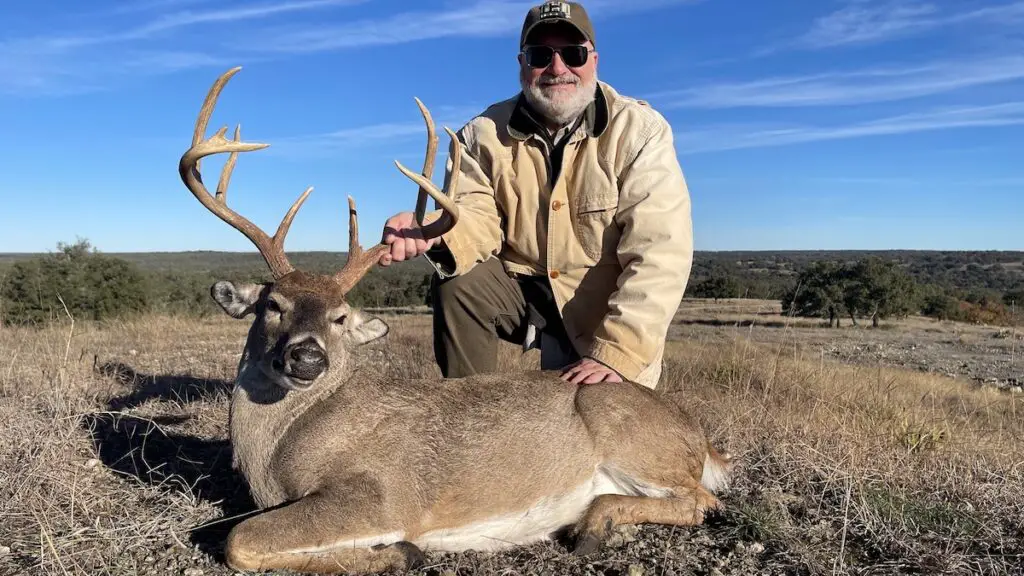
As popular effective as the 270 is for deer hunting though, there’s not a darn thing wrong with using the 308 for deer hunting either.
I killed my first two deer with a Winchester Model 70 Featherweight in 308. My sister shot her first big game animal (a hog) with that same rifle a few years later. Her husband also took his first deer with that exact rifle in 2021.
We were all hunting under conditions ideally suited to the 308 (out of deer stands in areas where shots were typically in the 50-150 yard range) and the 308 performed great.
None of those animals went more than 50 yards afterwards.
It’s also worth mentioning that Milo Hanson used a Winchester Model 88 lever action rifle chambered in 308 Winchester to take the current Boone & Crockett whitetail back in 1993.
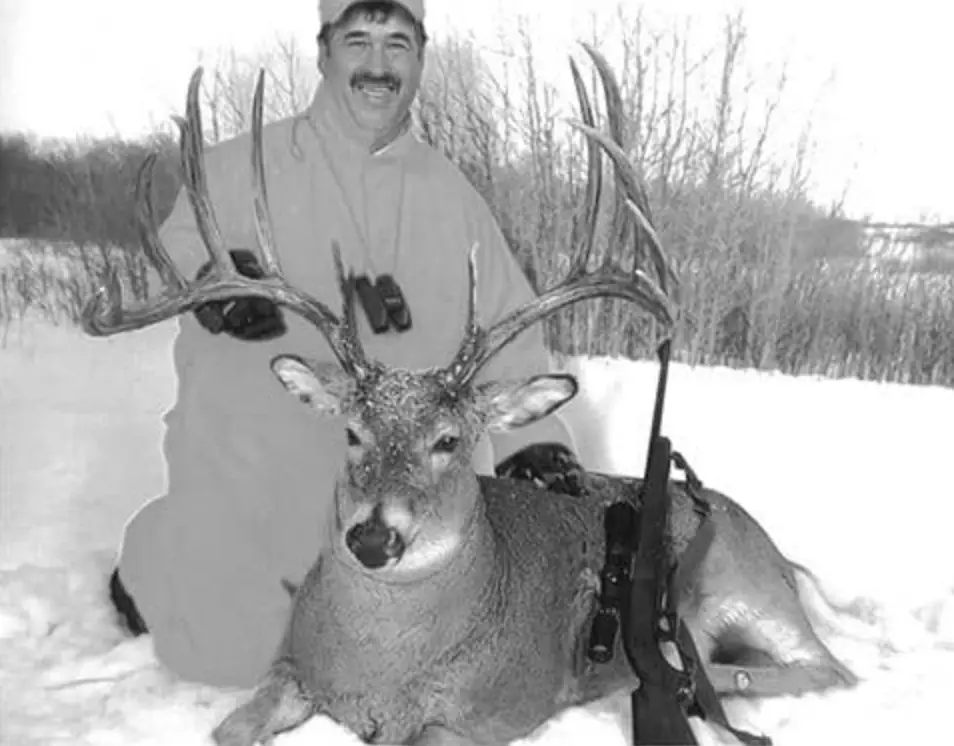
Are you looking for a more compact rifle that’s better suited for a younger and/or smaller framed hunter? Or perhaps a rifle ideal for a hunter going afield in very thick conditions or who will be hunting from a smaller box blind?
Or maybe you want something better suited for a more recoil shy hunter?
In each case, the 308 Winchester is the better option.
While it does have more recoil than other cartridges like the 243 Winchester and 6.5 Creedmoor, it’s still an excellent cartridge for new, small framed, and or recoil shy hunters. This is especially true when using light recoiling handloads or certain factory loads (like the Hornady Custom Lite line).
Likewise, the size difference with 308 vs 270 rifles means it’s much easier to find more compact rifles in 308 Winchester than for the 270 Winchester.
For instance, a friend of mine has a Bergara Ridge with an 18″ barrel chambered in .308 Winchester and his 9 year old daughter has used it to take several deer and hogs. That rifle is the perfect size for her to handle comfortably, recoil isn’t bad at all, it’s really easy to maneuver in a deer stand, and it’s also darn effective on deer sized game out as far as she’d reasonably be shooting anyway.
Plus, a hunter could mount a suppressor on a rifle like that without turning it into a giant, unwieldy musket. That extra 4-8″ of barrel length is a BIG deal when comparing a 270 with a 22-24″ barrel to a 308 with a 16-18″ barrel in a situation like that!
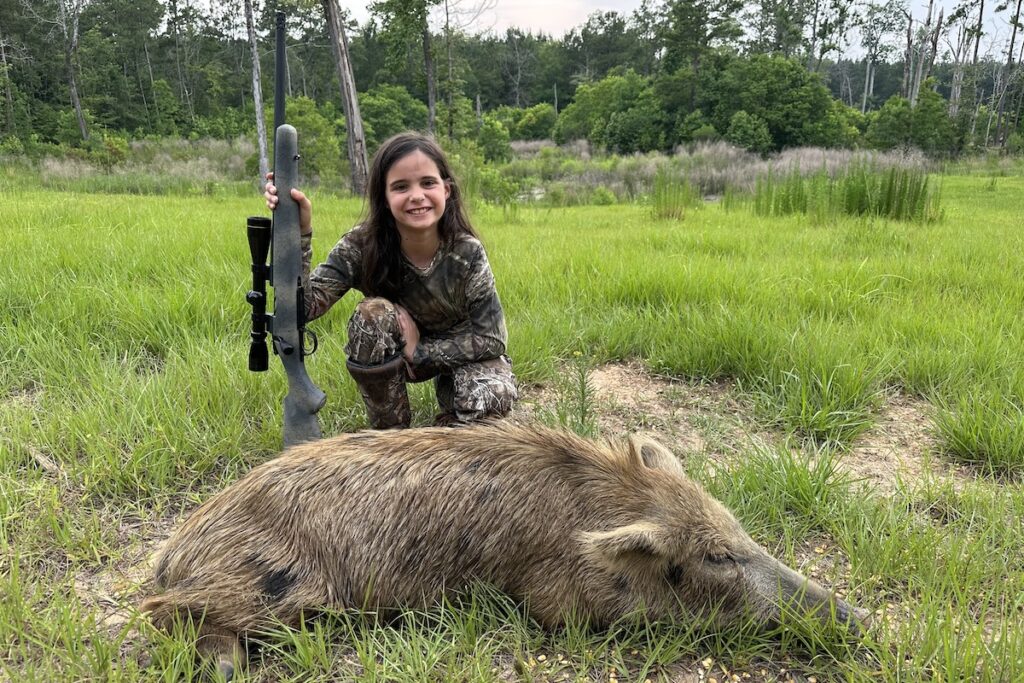
Are you looking for the cartridge better suited for long range hunting for game like mule deer or pronghorn in open country where you might need to take a shot at several hundred yards? Both will work, but the .270 Winchester is probably the better choice for you. With a significantly flatter trajectory and more resistance to wind, the cartridge does very well on longer shots, particularly on thin skinned game like mule deer, pronghorn, and sheep.
The video below of a hunter cleanly taking a whitetail at 475 yards with a 150gr AccuBond Long Range from his 270 Winchester is a great example of how the cartridge excels in this area.
Do you want to hunt larger game animals like kudu, eland, red stag, elk, or moose? Both cartridges will certainly work and lots of people have used them with success on bigger game.
I think the 270 Winchester is a wonderful elk hunting cartridge. In fact, a lot of outfitters really like the 270 because it’s so darn effective and so many hunters can shoot it really well.
A friend of mine is a serious fan of the 270 and he’s the sort of guy hunting guides like to see when he arrives in camp: he has an old and clearly well used, but well cared for Ruger M77 in 270 Winchester that he uses for everything
Though he has never taken an elk, he has successfully taken several moose with that rifle along with a caribou and truckloads of deer.
This guy used a 150gr AccuBond Long Range on his most recent moose and the results were impressive.
The moose was quartering towards him at about 300 yards, but that bullet punched straight through the shoulder blade and shredded his vitals. He said the bull staggered, then turned and gave him a broadside shot, during which he put another bullet through the lungs, after which it collapsed.
Can’t ask for much more than that on large game like moose.
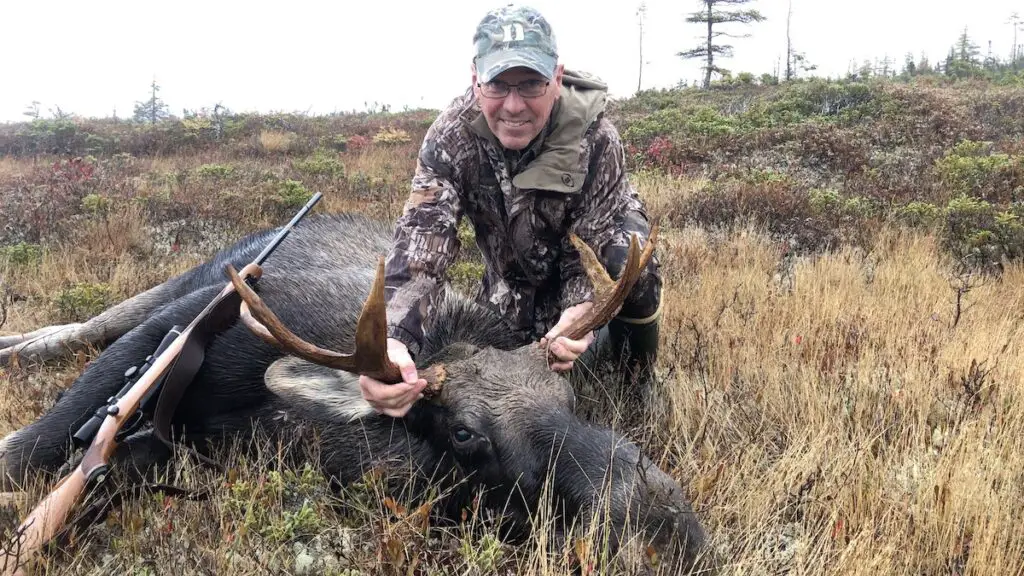
While the 270 Winchester does carry more energy out to several hundred yards, I also concede the cartridge doesn’t have a giant advantage over the 308 Winchester.
This is especially true at short range.
In fact, this is an area where the 308 Winchester’s edge with larger diameter and heavier bullets can come into play.
Elk are big and tough creatures and the larger frontal diameter and more kinetic energy of the 308 Winchester (at shorter ranges anyway) are definitely helpful when trying to cleanly take a big animal like that.
For instance, Randy Newberg has taken lots and lots elk using the .308 Winchester over the years.
He tends to take most of his elk inside 300 yards (and often inside 200 yards) and he always uses premium bullets like the 165gr Nosler Partition. Even the biggest and toughest elk won’t go very far after taking a bullet like that through the vitals.
Regardless of which cartridge you choose, use a controlled expansion projectile and a heavier bullet weight for your elk or moose hunt.
Are you looking for a great cartridge for sheep, mountain goat, or tahr hunting where you need an effective cartridge with manageable recoil in a lightweight and easy to carry rifle?
The .308 Winchester is a perfectly capable long range cartridge and plenty of hunters use it on mountain hunts each year.
However, the 270 Winchester’s flat trajectory, good resistance to wind drift, better energy retention at extended range, and it’s relatively light recoil makes it easier to handle in a lightweight rifle that’s desirable on a mountain hunt. Jack O’Connor was really onto something with his affinity for the .270 as a sheep hunting cartridge.
The second ram from the left in the photo below is the same sheep I showed you earlier in this article. O’Connor took that particular stone sheep on a hunt in British Columbia in 1946 with a 270 Winchester firing a 130gr Winchester bullet.
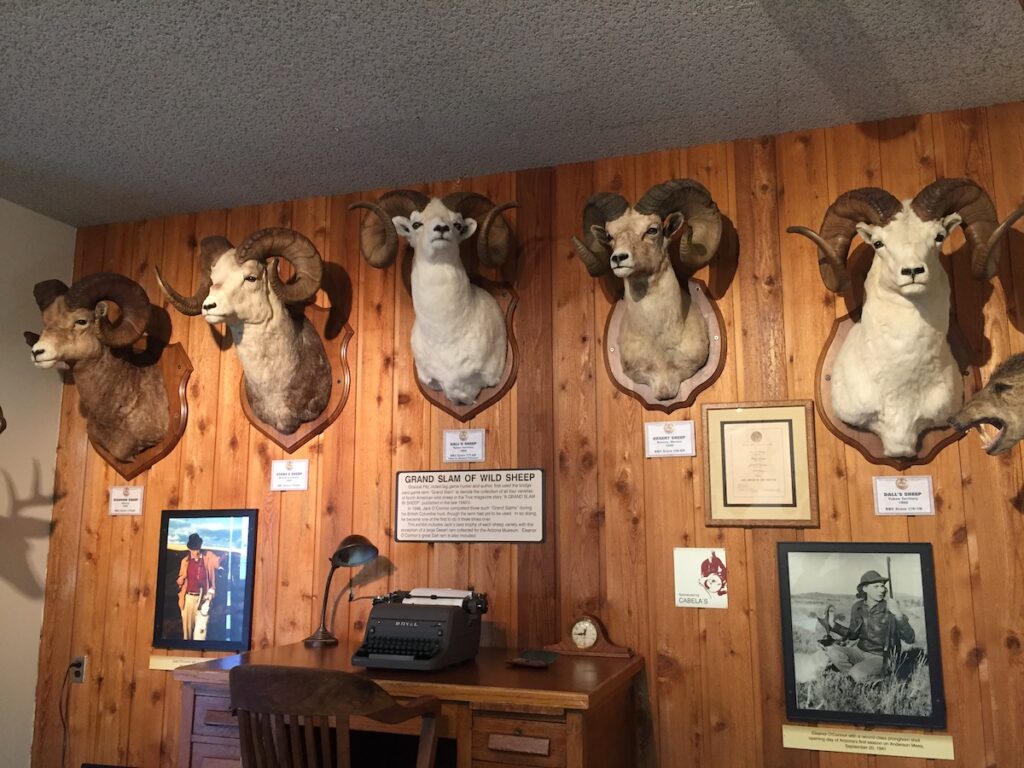
Do you want to use a semi-automatic rifle for hunting (like for higher volume hog control work) or want a battle rifle for personal defense? The choice here is very easy: go with the .308 Winchester as there are many more quality semi-auto rifles available in this cartridge than the 270 Winchester.
308 vs 270 Winchester Final Thoughts
The 270 Winchester and 308 Winchester are both excellent rifle cartridges for a lot of hunting situations. In fact, I can’t pick a clear winner between the two of them.
I’d steer you towards the 270 Winchester if you’re looking for a cartridge better suited for more open country hunting situations where shots at longer ranges are more likely.
Likewise, I recommend the 308 Winchester for hunters unlikely to shoot at game past 200 yards as well as those who want a more compact and/or lighter recoiling hunting cartridge.
The same is also true for those who want a semi-automatic rifle or for those who want the best ammunition selection where the 308 also shines.
To be perfectly candid with you, I’m a 308 Winchester man myself, but I also recognize the strengths of the 270 Winchester.
In the end, while the differences between them (270 vs 308) are pretty significant in some respects, they’re both acceptable for a wide range of hunting tasks. Carefully analyze your needs, get a nice hunting rifle chambered in the cartridge that you think fits your specific hunting situation the best, learn to shoot it well, use quality bullets, and you’ll be well prepared for most common hunting situations.
Enjoy this article comparing the .270 and .308 Winchester cartridges? Please share it with your friends on Facebook and Twitter.
The Lyman 50th Edition (197-198, p241-245), and Hornady 10th Edition (p251-355, p474-488) reloading manuals were also used as references for the history of the cartridges and provided data to compare their size and recoil. Ballistic data for the original 7.62x51mm military cartridge was obtained from Inetres. The data used to compare the trajectory and wind drift of the cartridges was obtained from Federal. Maximum pressure obtained from SAAMI (p171 and p172). Case capacities for the .270 Win and .308 Win were obtained from Nosler. I used the Federal Ballistic calculator and ShootersCalculator.com to compare wind drift, the range each bullet goes subsonic, and recoil for the cartridges.
Make sure you follow The Big Game Hunting Blog on Facebook, Instagram, Twitter, and YouTube.
NEXT: 7mm REM MAG vs 300 WIN MAG: WHAT YOU KNOW MAY BE WRONG
NEXT: 11 BEST HUNTING EAR PROTECTION OPTIONS FOR SPORTSMEN
NEXT: 101 BEST GIFTS FOR HUNTERS
John McAdams is a proficient blogger, experienced shooter, and long time hunter who has pursued big game in 8 different countries on 3 separate continents. John graduated from the United States Military Academy at West Point and is a veteran of combat tours with the US Army in Iraq & Afghanistan. In addition to founding and writing for The Big Game Hunting Blog, John has written for outdoor publications like Bear Hunting Magazine, The Texas State Rifle Association newsletter, Texas Wildlife Magazine, & Wide Open Spaces. Learn more about John here, read some of John’s most popular articles, and be sure to subscribe to his show: the Big Game Hunting Podcast.

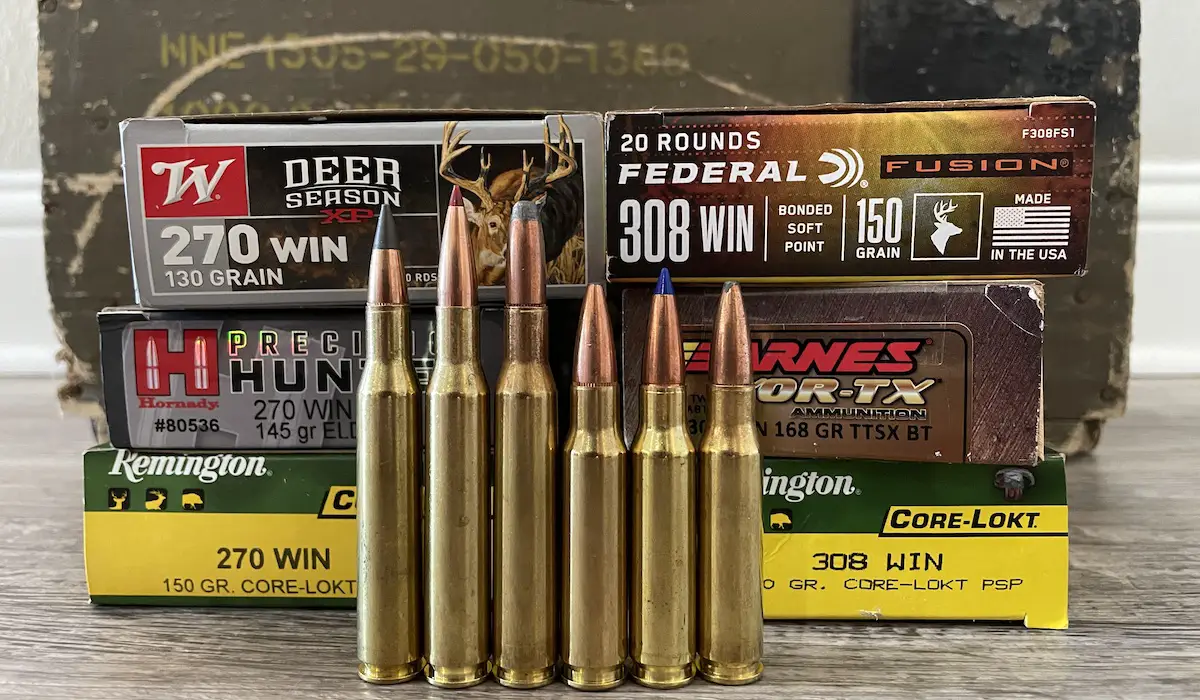


My solution to this dilemma was to have one of each, (I actually have 2 .308s) in addition to the .30-06. I have always been a believer in heavier bullets regardless of the difference in drift because of lower BCs with heavy’s. This is only a preference, not a requirement for me. The .270 Win is a very efficient round for most hunting, but, if I’m going for moose I want nothing less than the .30-06. I also think the heaviest bullet for the .308 should be no more than 165 grains. In my opinion the 180 grainer bullet is too heavy for the smaller powder capacity for the shorter cartridge. This can cause excess barrel wear and damage. Therefore, I rule out using the .308 for moose because I think a 165 grain bullet is too light for an animal that size unless you have the velocity created by the .270 Win. But, even then I think the hunter is on a very thin edge of killing efficacy. For target shooting, knock yourself out and take both to the range and have a ball.
I like the 308 over the 270, but if I needed a vary long shot I would go with the 300 win mag. How ever living on the east coast most shots are very short and there for would go with a 444 marlin, when shooting within 200 yd do not want a bullet that will travel miles. But if I were to go out west and shoot long range it would be a toss up between the 308 and the 300 win mag. depending on how long the shots would be.
The 444 marlin puts a big hole in one side and out the other leaving a good blood trail if you have to track, but an animal hit with a 444 marlin mostly drops on the spot,or goes less than 25 – 50 yards. Recovery of the animal is a must.
There has been many moose found that were shot and never recovered by the hunter because of lack of a blood trail, so use what will drop it in its tracks or at least leave a good blood trail.
I started out hunting mule deer with a borrowed Winchester 30-30 and had very good luck with it. My shots rarely exceeded 125 yards or so in the foothill country that I hunted in central Wyoming. Eventually, I wanted to go after elk but wanted to remain with a lever action so in 1972 I bought a Savage 99 in .308 shooting 180 grain core-lokt ammo. This rifle accounted for several bulls and many cow elk; my longest shot was about 225 yards. The faster 150 grain bullets were tried for mule deer but I was disappointed with the significant meat damage. So I bought a Glenfield carbine in 30-30 and fitted it with a 2-7X scope. This carbine is my favorite for deer sized animals. I moved away from Wyoming and settled here along the Gulf Coast of Florida where deer are much smaller. The Glenfield 30-30 is my main rifle for deer and wild hogs. In summary, I had very good luck with my .308 downing elk and a couple bears but it’s too powerful for common deer at typical distances hunting the forests and foothills.
my choice is the 270 win, shooting range for animals is most in the 200 yards. for longer range better go for the 7mm Rem Mag or 300 Win Mag/300 Wby Mag with 180gr
270 is a nice cartridge; however, I think if the 280 Rem had come out at the same time, the 270W would be a footnote in history. They’re both about the same up to 150 gr bullets, but 160 and 175 gr bullets are easily obtained for 280R, and in a wide variety of cartridge and bullet makers.
In this hunter’s opinion, 175 gr 280 Rem and 180 gr 308W hit a sweet spot in bullet performance. At a MV of around 2600 fps, nearly all bullets will perform reasonably well, both ballistically and, more importantly, terminally out to 200 or 250 yards. Higher velocity certainly means higher KE and flatter shooting, but it doesn’t guarantee penetration. While 2900 fps sounds cool and all, a high impact velocity means the bullet will almost certainly fragment on impact when using lower-end bullets. I’m more than happy to shoot inexpensive bullets like Speer Grand Slam (180 gr and 175 grain, respectively) out of a 308 or 280 Rem. But I’d opt for something of stouter construction for a 130 gr 270, which means a bit more expensive. 130s have certainly proven their lethality over time, but I’m primarily a meat hunter, and I’ve been less than pleased with what 150 gr 308 does to meat. A 270 in 130 gr suffers the same shortcoming.
Heavier, more stoutly-constructed bullets are almost universally better at penetration, given their lower velocities. Momentum (not KE) is king when it comes to penetration, and heavier bullets retain it better than lighter bullets. Excepting 375 H&H and 375 Ruger, there’s a reason dangerous games cartridges aren’t generally any faster than about 2200-2300 fps.
Again, 270 is a fine cartridge, but whatever you shoot, you need to understand that cartridge’s limitations.
All cartridges/rifles are a balancing act between
1. price
2. recoil
3. trajectory
4. penetration
We all have our own hierarchy of values, and mine favors penetration over all else, but that does come with cost – more expensive, more recoil, and more arcing trajectories.
Thanks Brian. Once again, you hit the nail on the head.
John
P.S. For other readers: you can see what Brian is talking about with regards to the 270 Winchester vs the 280 Remington at the link below. Remington made a great cartridge in the 280, but really botched the rollout and the cartridge has never recovered.
https://thebiggamehuntingblog.com/270-vs-280-remington-vs-280-ackley-improved-vs-7mm-mag/
Great article both of these rounds are plenty capable of humanly killing most North American medium to large game
Species not Browm Bear I firmly believe that shot placement and the correct choice of ammunition plays a great role in all hunts know your rifles capability and your own limitations to insure humane kills respect the animals God has blessed us with to provide awesome meals for our families take great shots be patient teach the next generation about safety and our hunting tradition choose a rifle that your comfortable firing we are hunters not snipers respect our wildlife make great decisions clean humane kills with correct ammo for the animals you hunt